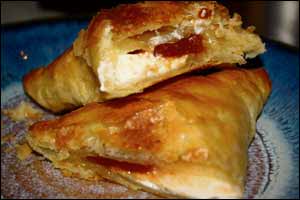| FOOD | |
| Shavuot staple’s Greek beginning | |
They constituted the majority of wedding cakes, and were also used to feed Olympic athletes. It was then adopted when Rome conquered the Aegean region. Roman-era cheesecakes were known by two names: ‘libum’ and ‘placenta’. The medieval period saw a development that was to change the taste of cheesecake forever — the invention of soft, creamy Neufchatel cheese in the Norman town of Neufchatel-en-Bray. The Oxford Companion to Food asserts that the earliest of the modern European cheesecake recipes discovered appears in the 1390 London work Forme of Cury under the title ‘Tart de Bry’. Cheesecakes entered the modern era running strong, with colonial immigrants to America bringing different recipes from Britain, France and Germany. New York-style cheesecake, one of the best-known varieties, has a complex history. Italians coming to the city at the end of the 19th century brought with them a series of ricotta-based cakes, which can still be found throughout New York; but it is frequently Jewish immigrants who are credited with the diffusion of the cream cheese-based concoction that began to sweep Jewish delicatessens as early as the 1920s. Arnold Reuben, owner of the Turf Restaurant, took credit for inventing the first cake based on cream cheese, while others still relied on cottage cheese and other soft, white cheeses. By the 1940s, Lindy’s, a popular Broadway hangout, became the alpha and omega of the cheesecake scene, where New York’s glitterati fed on the calorie-heavy delight. The cream cheese-based cake has become so completely identified with American Jewish culinary culture that Jewish cooking denizen Joan Nathan dedicated an entire episode of her 26-part series Jewish Cooking in America to a search for the best version of the product. Many central and eastern European Jewish recipes tend to be based on cottage cheese. Cheesecake, it turns out, is far beyond what anyone ever imagined. But over 2,000 years of appreciation goes to show that no matter what cheese is used — cheesecake is here to stay.
Pasteles De Guayaba Y Queso THIS recipe — which is perfect for Shavuot — is adapted from To Cook is to Love. Author John Verlinden uses reduced-fat cream cheese to make the filling lighter. If you can’t find guava paste, substitute other fruit preserves. To give the pastries a golden brown colour, you can brush the dough with egg glaze before baking. Ingredients
Method Position rack in centre of oven and preheat to 205°C. Line a baking sheet with parchment paper. In a mixer, beat cream cheese with sugar, 1 egg, vanilla and salt to a smooth mixture. If guava preserves have pieces, puree in a food processor, adding 1 tbsp water if preserves are too thick. Remove one puff pastry sheet from the package. If it is folded, unfold it. If pastry sheet is thick, roll it to flatten it slightly. Cut the sheet into three pieces lengthwise, then in two pieces crosswise. Spread a thin layer of cream cheese mixture onto 1 piece of dough, leaving the edges uncovered. Spoon a row of preserves over the centre of the cream cheese. If using egg glaze, brush it around the edges. Fold the piece of dough in half, enclosing the guava preserves and sticking the dough together at the edges, forming a rectangle or a square. Seal all edges with a fork. Transfer to baking sheet. Repeat with remaining dough, arranging pastries on baking sheet so they don’t touch each other. Refrigerate for 15 to 30 minutes before baking. If desired, brush pastries lightly with beaten egg. Bake for 15 minutes or until pastry puffs and is golden brown. Check often; be careful not to overbake. Cool on a rack.
|
